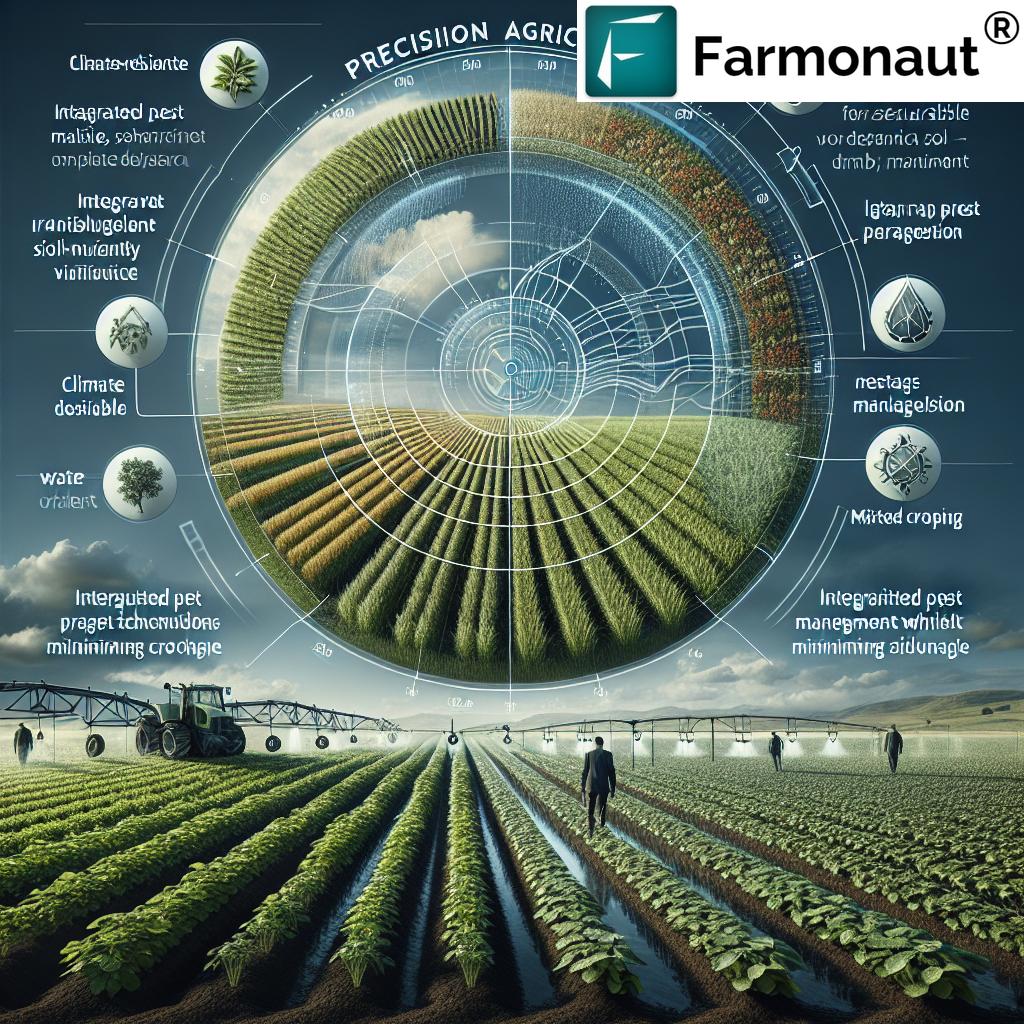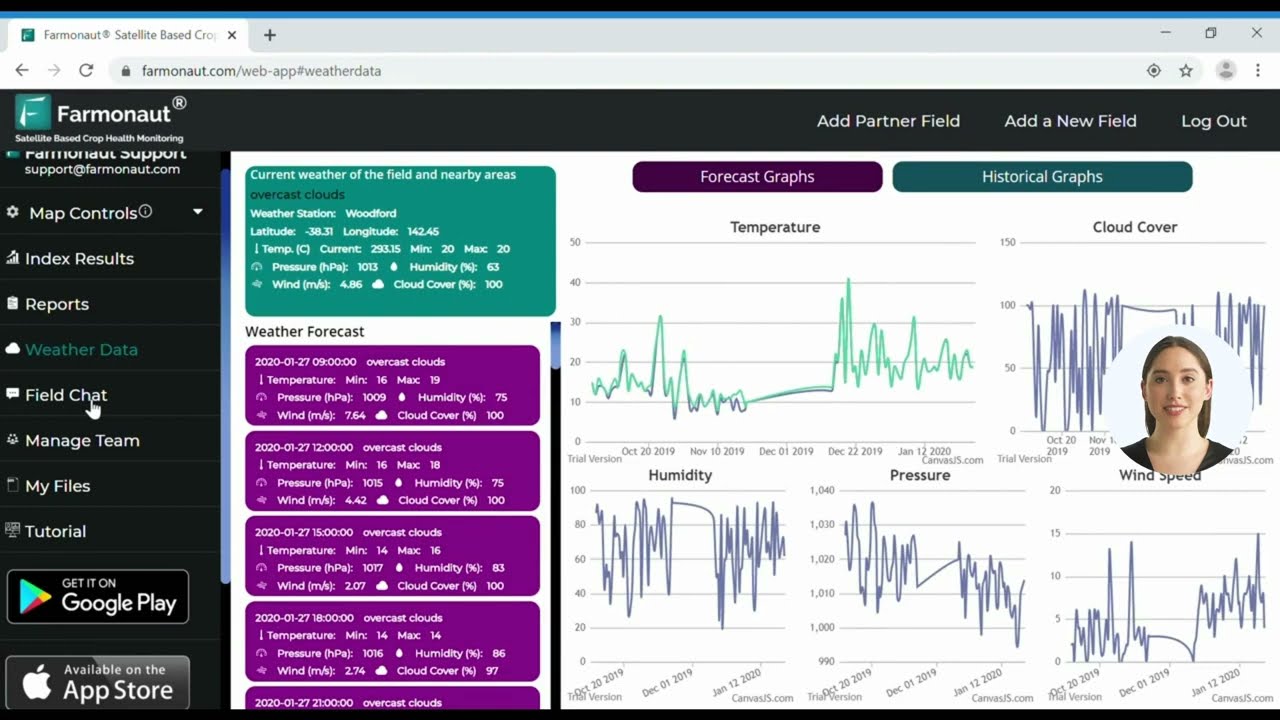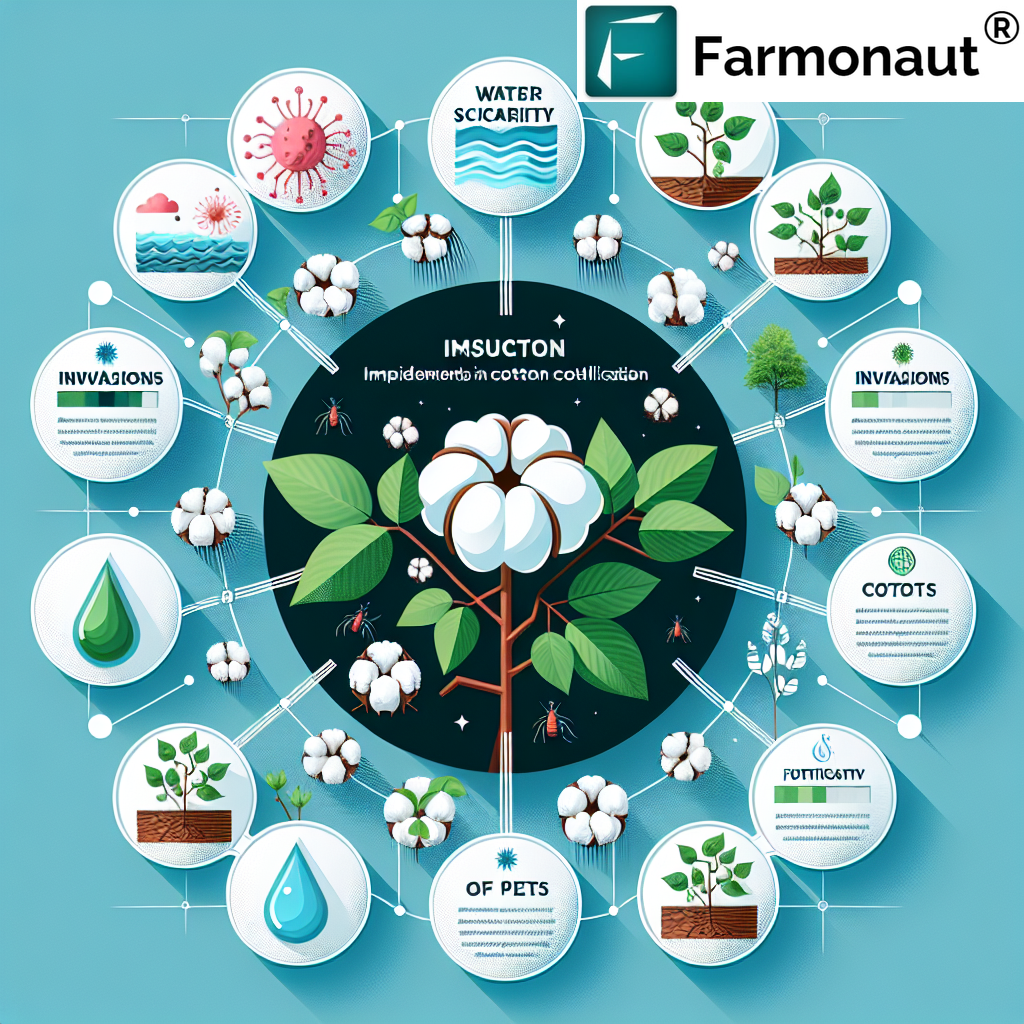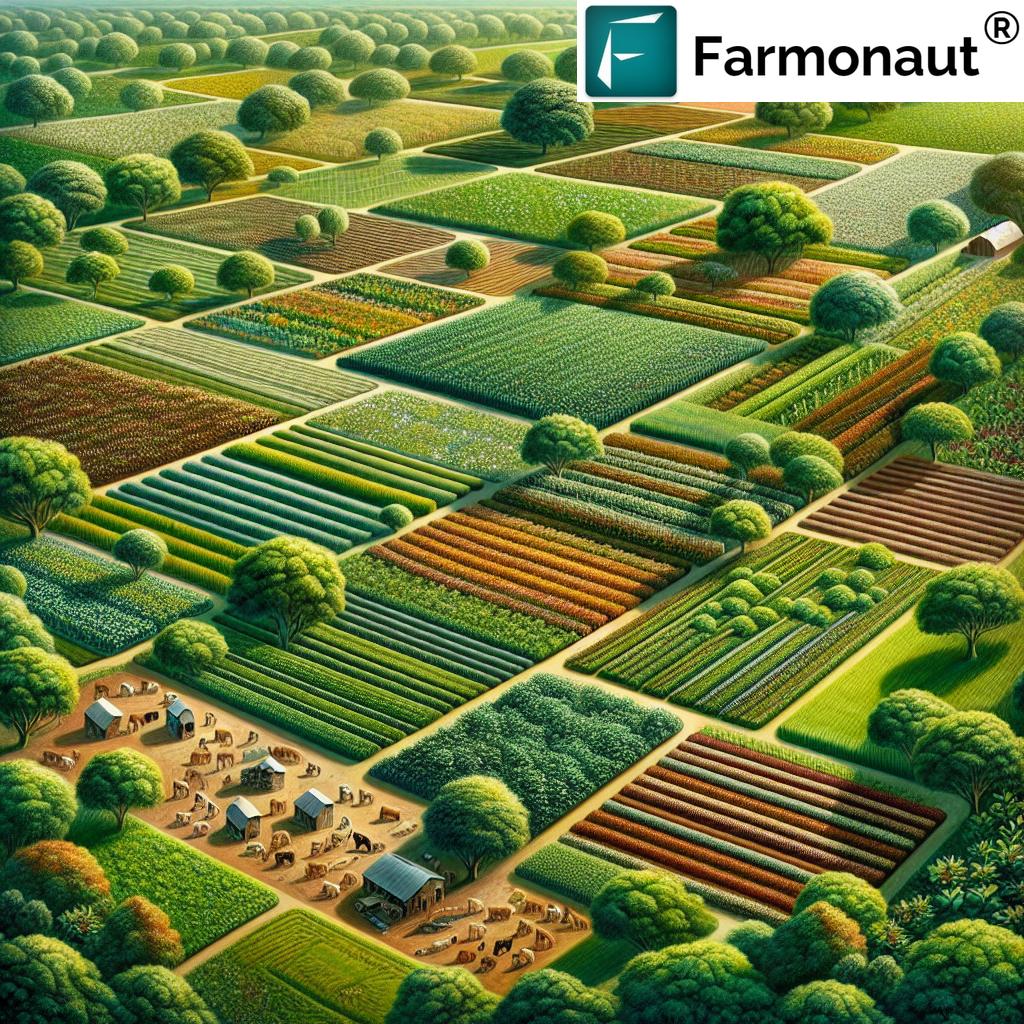Crop Production: 7 Hacks to Skyrocket Your Yields!
“Adopting climate-smart agriculture can increase crop yields by up to 25% while reducing greenhouse gas emissions by 30%.”
Table of Contents
- Introduction: The Fundamentals of Crop Production
- Hack 1: Mastering Soil Fertility Management
- Hack 2: Advanced Water Management in Agriculture
- Hack 3: Climate-Smart Crop Production for Resilient Yields
- Hack 4: Integrated Pest Management for Sustainable Farming
- Hack 5: Precision Agriculture Technologies
- Hack 6: Sustainable and Organic Practices
- Hack 7: Harnessing Technological Innovations for the Future
- Comparative Techniques & Estimated Impact Table
- Farmonaut: Revolutionizing Crop Production
- FAQ
- Conclusion
Introduction: The Fundamentals of Crop Production
Welcome to our comprehensive guide on crop production and how we can leverage innovative strategies to maximize yield, sustainability, and ensure future food security. Agriculture is the backbone of global food supply, with crop production encompassing the cultivation of plants for food, fiber, medicinal purposes, and other essential products. Success in this field relies on a precise interplay of biological, environmental, economic, and technological factors—all aimed at optimizing yield and quality of our crops.
The foundation of productive crop management starts with selecting appropriate plant species, preparing the soil, proper planting techniques, and extends to managing the growth conditions meticulously until harvesting mature crops of superior quality.
Key factors influencing crop production include soil fertility, water availability, climate conditions, pest and disease management, environmental stewardship, as well as the use of cutting-edge agricultural technologies.
Understanding the Challenges & Opportunities in Crop Production
Today’s farmers face a dual mission: to increase crop production for a growing population while embracing sustainable agriculture practices to safeguard our environment and resources for future generations. We encounter issues like soil fertility decline, water scarcity, climate change–induced instability, persistent pest and disease pressure, and increased costs. Yet, technological advancements and renewed awareness of ecological stewardship provide us unparalleled opportunities to transform agricultural methods.
Hack 1: Mastering Soil Fertility Management
Why Soil Fertility Matters in Crop Production
Healthy, fertile soil is the foundation of successful crop yields. It consistently provides the nutrients our plants need for vigorous growth, quality produce, and resilience to environmental stress. Let’s explore how soil fertility management can become the game-changer for sustainable, high-yield agriculture.
Key Soil Fertility Practices for Optimizing Crop Production
- Crop Rotation: Alternating crops on the same land to improve nutrient balance and soil structure, as well as managing pest populations and disease cycles.
- Incorporation of Organic Matter: Adding compost, farmyard manure, and plant residues to support microbial activity, maintain structure, and enhance nutrient availability.
- Use of Cover Crops: Planting non-cash crops like legumes or grasses to cover and protect soil off-season. These cover crops are vital for reducing erosion, fixing atmospheric nitrogen, and improving biodiversity.
- Conservation Tillage: Reducing disturbance to preserve soil health, decrease erosion, and enhance water retention. Techniques include no-till, minimum tillage, and strip-till methods.
- Balanced Fertilizer Application: Integrating organic and inorganic fertilizers tactically to meet plant nutrient needs while reducing environmental impact. This tailored approach ensures maximum benefit without overuse.
By mastering these soil management strategies, we are not only improving crop quality and yield but also establishing sustainable production systems to :
- Optimize nutrient cycling,
- Maintain healthy root development,
- Reduce dependency on chemical inputs.
Tip: Leverage satellite-based crop monitoring with Farmonaut to detect areas with poor soil fertility using real-time NDVI (vegetation health) data, and plan targeted interventions for optimal crop production.
To further understand soil carbon’s role in fertility, watch:
Unlocking Soil Organic Carbon: The Secret to Sustainable Farming with Farmonaut.
Explore our comprehensive carbon footprinting solutions for tracking and reducing farm emissions. Learn more here →
Hack 2: Advanced Water Management in Agriculture
Efficient Water Management: Key to Resilient Crop Growth
Water is a critical input for healthy plants and robust crop yields. Yet, with fluctuating rainfall patterns and increased competition for resources, we must employ innovative water management in agriculture to ensure each drop counts.
Essential Water Management Techniques
- Drip Irrigation Systems: Deliver water precisely to plant roots, minimizing evaporation and runoff, and improving water use efficiency by up to 90% compared to traditional methods.
- Rainwater Harvesting: Collect, store, and use rainwater for critical crop periods. This reduces dependency on groundwater or external sources and buffers against drought.
- Moisture Sensing & Soil Monitoring: Utilize IoT-enabled devices and satellite insights (like Farmonaut’s Farm Management App) to measure moisture levels and schedule irrigation precisely.
- Mulching: Use organic and inorganic materials to cover the soil, retaining moisture and reducing weed competition.
- Field Levelling: Ensure uniform water distribution and prevent waterlogging and nutrient leaching.
By integrating these practices, we enhance drought resilience, conserve resources, and reduce irrigation costs—all while supporting plant growth and yield quality.
Did you know? Farmonaut’s crop monitoring platform uses satellite-based water stress and soil moisture analytics to help farmers make smarter irrigation decisions, boosting yield and saving water. Build advanced implementations via our API (see developer docs).
“Efficient soil and water management practices can boost farm productivity by 20% and conserve up to 40% more water.”
Hack 3: Climate-Smart Crop Production for Resilient Yields
Adapting Planting and Management to Weather Realities
Unpredictable climate patterns—altered rainfall, rising temperatures, and extreme events—demand a climate-smart crop production approach. We must anticipate climate-induced risks and modify planting and management practices accordingly.
Strategies for Climate-Smart Agriculture
- Selecting Drought-Resistant and Climate-Resilient Varieties: Use seed varieties bred for stress tolerance, early maturing features, and heat or flood resistance.
- Altering Planting Schedules: Adjust planting windows to sync with rainfall patterns and temperature, minimizing exposure to climatic extremes.
- Agroforestry and Mixed Cropping: Integrate trees and different crops to buffer against weather variability, enhance biodiversity, and maintain microclimates.
- Mulch and Soil Cover: Protect soil from temperature swings and conserve moisture.
- Real-Time Weather and Crop Risk Monitoring: Leverage tools like Farmonaut Jeevn AI Advisory System for weather alerts and guidance on mitigating climate risks.
As climate change continues to impact crop development and yield, these adaptations are not just optional—they are crucial for maintaining productivity and securing food systems.
Hack 4: Integrated Pest Management for Sustainable Farming
The Sustainable Alternative to Chemical Pesticides
Understanding Integrated Pest Management (IPM) allows us to manage pests in a more balanced, eco-friendly, and cost-effective manner.
Principles of Effective Integrated Pest Management (IPM)
- Monitor & Identify: Regular field inspections and technology-enabled (e.g., satellite imagery) identification of pest hotspots.
- Biological Controls: Use of natural predators, parasitoids, and disease-suppressive crops.
- Cultural Practices: Crop rotation, intercropping, and timely plant residue management to break pest life cycles and reduce disease risk.
- Mechanical Methods: Physical barriers, traps, and manual removal.
- Chemical Controls: Targeted, minimal, and safe use of pesticides when absolutely necessary.
With a robust IPM approach, we protect both our yield and the surrounding environment while reducing reliance on chemicals. Technologies from Farmonaut, such as satellite-based crop health monitoring, detect pest infestations at the earliest stage, empowering smarter interventions and resilient crop production.
Want to ensure traceability and safety in your food supply? Explore Farmonaut’s blockchain-based traceability solutions—designed to provide transparency from “farm to fork.”
Hack 5: Precision Agriculture Technologies
Leveraging Data and Technology for Optimal Results
Modern crop production is increasingly data-driven. Precision agriculture technologies empower us to monitor field variability, determine precise input needs, and automate major farm decisions.
Game-Changing Precision Agriculture Practices
- Satellite Remote Sensing: Real-time, spatial monitoring of crop health, soil moisture, and pest/disease outbreaks (NDVI/NDWI maps).
- Variable Rate Application: Applying water, fertilizers, and pesticides variably, matching exact crop requirements and avoiding overuse.
- Yield Prediction Analytics: Forecasting harvest outcomes using AI and historical data for better business planning.
- Digital Recordkeeping & Fleet Management: Track farm machinery, input usage, and operations with centralized dashboards.
Learn how Farmonaut’s Fleet & Resource Management tools can reduce operational costs and optimize machinery for sustainable farming.
The adoption of precision ag isn’t just a boost for short-term profits—it sets us on the path to sustainability by minimizing waste, reducing input costs, and proactively managing environmental risks.
Hack 6: Sustainable and Organic Practices
Building Long-Term Yield and Food Security
Moving towards sustainable agriculture practices ensures our systems will endure and flourish for generations. From using organic inputs to integrating trees with crops (agroforestry), these techniques restore soil health, enhance biodiversity, and reduce farming’s ecological footprint.
Key Sustainable and Organic Approaches in Crop Production
- Organic Farming: Use of compost, biofertilizers, green manure, and biological pest controls. No synthetic chemicals, supporting healthier soils and safer produce.
- Agroforestry: Integrate productive trees and shrubs with crops or pasture. These systems increase resilience, sequester carbon, and diversify farm income.
Discover how Farmonaut’s Crop Plantation & Forest Advisory solutions enable smart decisions in mixed agriculture systems.
- Cover Cropping & Green Manuring: Use of cover crops to reduce erosion, add nutrients, suppress weeds, and prevent soil degradation in off-seasons.
- Reduced Tillage: Lower soil disturbance conserves organic matter and mitigates erosion.
- Biodiversity Conservation: Planting buffer strips, maintaining field margins, and protecting pollinator habitats.
Adopting these practices helps us reach new levels of soil fertility, safeguard natural resources, and contribute reliably to food security and crop production.
Hack 7: Harnessing Technological Innovations for the Future
Preparing for Tomorrow’s Challenges in Crop Production
To sustainably achieve higher yields amidst growing challenges—climate change, resource scarcity, and fluctuating market conditions—we need to innovate continually. Let’s explore the transformative power of new-generation agricultural technology, focusing on tools that promote economic, social, and environmental sustainability in farming.
Cutting-Edge Technologies for Sustainable Crop Yield
- Artificial Intelligence (AI) & Machine Learning: Models that process remote sensing data and provide actionable insights for precise crop and resource management.
- Blockchain Traceability: Secure, verifiable records of crop origins, quality metrics, and supply chain events (see Farmonaut traceability solutions).
- Automated Advisory Systems: Personalized, AI-driven recommendations (such as Farmonaut’s Jeevn AI) that synthesize weather, crop stress, pest alerts, and satellite insights.
- Advanced Monitoring Platforms: Apps and dashboards providing real-time NDVI, soil moisture, and risk alerts for full operational control (learn about Farmonaut’s platform for multi-hectare farm management).
- API Integration: Connect your systems with satellite data using Farmonaut’s API and developer documentation for scalable, custom agtech solutions.
These advancements allow us to overcome traditional limitations, monitor large fields remotely, and make data-driven interventions for optimal crop yields and reduced resource wastage.
Comparative Techniques & Estimated Impact Table
The table below summarizes our top 7 crop production hacks, detailing their core method, estimated yield increase (%), sustainability score, water savings, and distinct long-term benefits. This provides actionable insights for choosing the right practices that align with both yield maximization and sustainability.
| Technique Name | Method Overview | Estimated Yield Increase (%) | Sustainability Score (1–5) | Water Savings (%) | Notable Long-Term Benefit |
|---|---|---|---|---|---|
| Soil Fertility Management | Crop rotation, organic matter, balanced fertilizers, conservation tillage | 20-25 | 5 | 10-15 | Enhanced soil health and structure |
| Advanced Water Management | Drip irrigation, rainwater harvesting, soil moisture monitoring | 15-20 | 5 | 20-40 | Drought resilience, reduced water expenditure |
| Climate-Smart Crop Production | Drought-resistant varieties, altered planting schedules, agroforestry | 15-25 | 5 | 5-10 | Field stability despite climate risks |
| Integrated Pest Management | Combination of biological, cultural, mechanical, and targeted chemical controls | 10-15 | 4 | ~0 | Sustained crop health, reduced residues |
| Precision Agriculture Technologies | Satellite analytics, variable inputs, automated irrigation, fleet/resource tools | 25-35 | 4 | 20-30 | Maximized efficiency and profitability |
| Sustainable and Organic Practices | Agroforestry, cover cropping, biodiversity, organic fertilizers | 10-20 | 5 | 10-15 | Improved ecosystem services and food safety |
| Harnessing Technological Innovations | AI-powered advisories, blockchain, yield prediction, traceability | 15-30 | 5 | 5-10 | Rapid decision-making and transparent supply chains |
Farmonaut: Revolutionizing Crop Production through Technology
At the convergence of these 7 hacks stands Farmonaut—an agri-technology pioneer dedicated to democratizing access to affordable, precision agriculture and farm management resources for individual farmers, agribusinesses, and institutions worldwide.
- Satellite-Based Crop Health Monitoring: Receive NDVI, NDWI, and soil moisture data on an intuitive app—enabling you to spot plant stress, nutrient deficiencies, water issues, and pest outbreaks in real time.
- Jeevn AI Advisory: Personalized recommendations based on weather, field conditions, and crop stage for smarter, data-backed decisions.
-
Blockchain-Based Traceability: Ensure “farm-to-fork” transparency for crops and products, strengthening market reputation and meeting global compliance demands.
(Learn more) -
Fleet and Resource Management: Track and optimize farm machinery, logistics, and operations—all in one dashboard.
(Details) -
Carbon Footprint Tracking: Monitor emissions and adopt sustainability best-practices for future market advantage.
(See how it works)
Choose the Right Farmonaut Subscription for You
Frequently Asked Questions (FAQ)
- What is the most important factor influencing crop production?
Soil fertility, water availability, and climate conditions collectively have profound impact. Modern crop production demands integrating these with technology and proper management for best results.
- How does precision agriculture increase yields?
By providing real-time, spatially detailed insights into field conditions, precision agriculture ensures that water, fertilizers, and interventions are applied only where and when needed—maximizing yield while reducing waste and environmental impact.
- Can sustainable agriculture practices reduce costs?
Yes. Sustainable practices like cover cropping, IPM, and conservation tillage maintain soil health and biodiversity, ultimately reducing dependency on external inputs, lowering production costs over time, and increasing system resilience.
- How can blockchain traceability benefit my farm business?
Blockchain-based traceability improves transparency, safety, and compliance in food supply chains, opening up new markets and supporting higher price premiums for quality, sustainable produce.
- Where can I access Farmonaut’s services?
You can monitor your farm instantly using the Farmonaut web and mobile apps or connect your systems via API.
- Is there a way to get advice on insurance or crop loans?
Yes. Farmonaut offers tools to support crop loan and insurance verification via satellite , streamlining claims, and reducing fraud for both farmers and financial institutions.
- Who can use Farmonaut technologies?
Farmonaut serves individual farmers, agribusinesses, governments, NGOs, and corporate supply chains seeking enhanced productivity, transparency, and sustainability in farming operations.
Conclusion: Power Your Farm with Science, Sustainability & Technology
In today’s complex agricultural landscape, crop production is far more than just sowing seeds. It is a holistic blend of sustainable soil management, efficient water management, climate resilience, smart pest and disease management, technological innovation, and conscientious stewardship of our environmental and economic resources.
By implementing these 7 actionable hacks, we are poised not only to skyrocket our yields and ensure food security, but also to meet evolving sustainability mandates and set a global standard for environmentally responsible farming.
Leverage Farmonaut’s state-of-the-art agricultural technologies to transform your farm management today—and help us build a safer, more nourished, and sustainable future for all.



















